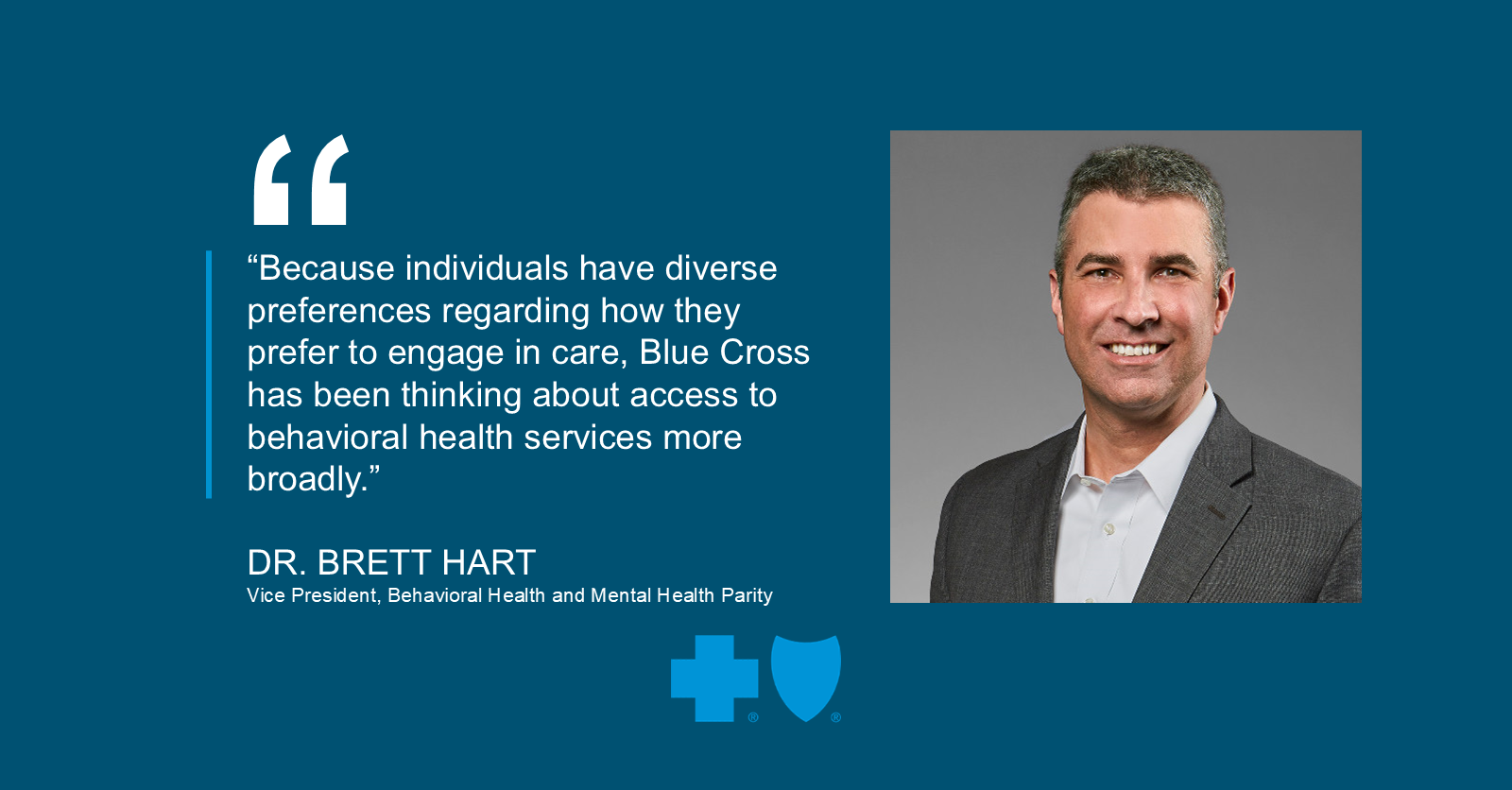Take 5: Dr. Brett Hart shares his views on the state of behavioral healthcare in MN
"Take 5" is a series in which we pose five questions to a Blue Cross and Blue Shield of Minnesota leader and learn more about who they are, what they do, and how they help our members live their healthiest lives.
This edition of “Take 5” features Dr. Brett Hart, Vice President of Behavioral Health and Mental Health Parity.
1. What is your perspective on the current state of behavioral healthcare?
The high demand for behavioral health services increased during the COVID-19 pandemic has persisted since, putting immense strain on the system. Behavioral health needs range from routine to highly complex. Because individuals have diverse preferences regarding how they prefer to engage in care, Blue Cross has been thinking about access to behavioral health services more broadly than traditional outpatient provider models or brick-and-mortar clinics. We’ve been focusing on unique and innovative solutions to improve access for our members.

For example, we increased access to behavioral health services by collaborating with three separate management service organizations (MSOs)—Grow Therapy, Headway and Rula Health. These online platforms act as conveners, bringing more therapists and psychiatrists that historically have not worked with insurance companies into the Blue Cross network. We also expanded our behavioral health network by adding Little Otter and Charlie Health in order to offer more virtual solutions for children and adolescents. And we made investments to build out a rural clinic model, like the Rural Behavioral Health Clinic at Minnesota State University, Mankato which opened in February. We’re focused on non-traditional strategies to meet the high demand for unique delivery approaches.
2. Where do you have hope for the direction behavioral health is heading in Minnesota?
We are seeing some real wins in the behavioral health space. Over the last few years, the rate of opioid dependence has decreased, which is a positive given the hold the opioid crisis has had on our country for a long time. The flip side is we’ve seen rising use among other substances, including alcohol and amphetamines. It’s an ongoing challenge that needs to be continuously evaluated and readdressed in different ways.
I also think we’re making inroads in addressing the systemic challenges around long wait times to see a behavioral health professional. Historically, depending on the condition, the wait to receive care could be weeks or even several months. With the expansion of our behavioral health network, members can now access care, including care for children with urgent needs, within 48 hours.
Technology is playing a role in this as well. If members are open to receiving care virtually, we can sometimes cut that wait time down to a day. In a space where getting care as quickly as possible can be critical, this makes me very hopeful.
3. What is the state of the fight against mental health stigma?
I’d love to be able to say that, as a society, we’re close to eliminating the impact of stigma around mental health. Unfortunately, there are still far too many people for whom stigma is a barrier to seeking help. That said, I think we have made great progress on behavioral health solutions that allow people to access care in a way that helps them avoid the stigma.
If someone was experiencing a severe or chronic substance abuse issue 10 or 15 years ago, that typically meant taking several weeks away from home and work and entering an inpatient or residential treatment facility. That’s a long time to uproot someone’s life. It can lead to a lot of speculation about where that person was, and judgement around the issue for which they were seeking treatment. Longer term in-person treatment may still be the best option in some cases, but today, we now have virtual solutions available where an individual can receive substance abuse treatment, as well as treatment for many other conditions, from home. They can go to work during the day, be a part of the community, then come home and participate in virtual treatment, greatly increasing convenience and decreasing stigma. It’s completely private. That’s a huge leap forward.
4. What do you want people to know about behavioral health and their Blue Cross plans?
We have been working to take some of the onus off the member when it comes to trying to figure out what help is needed, when, and the best delivery approach. Too often, I believe we expect individuals to be experts at diagnosing their own needs and navigating their way to the right solution.
For example, if a person woke up this morning and had sharp stomach pain, should that person be expected to self-diagnose and come up with a treatment plan? I think the fact that we commonly see individuals with the same symptoms choosing very different pathways (e.g., primary care, urgent care, emergency room, no care) tells us that we cannot expect people to be experts in their healthcare needs. Similarly, with behavioral health conditions, we have operated for far too long on the unrealistic assumption that people should be expected to know what type of care they need based on how they feel.
We have been working to design our navigation solutions for members in a way that allows them to use natural language to express their needs, without the expectation that they know exactly what’s wrong and what they need to do to feel better.
Along with that, we are building more sophisticated “push-to-member” solutions so we can help provide proactive assistance. For example, if an individual presents in an emergency room for a medical condition but they had a secondary diagnosis of untreated depression, we are developing approaches to proactively reach out to point that person to solutions that may be needed now or in the future to address that depression.
The bottom line is, we want to make use of the information we have to get people the best solution in the right location at the time it’s needed.
5. What do you see evolving in the behavioral health landscape in the future?
There has been a significant evolution in the use of innovative technology and Artificial Intelligence (AI) to treat behavioral health conditions. It started off more generically with basic telehealth. Since then, we’ve seen the market evolve to offer things like wearable devices for behavioral health monitoring, digital therapeutics where people can self-administer therapies and improved early detection around behavioral health than we have had in the past. Numerous companies have sprung up over the last few years that are deploying technology solutions to address behavioral health in ways that didn’t exist 10 years ago, and those advancements will continue.
Looking ahead, I think we will see more focus on preventive behavioral health care and behavioral health intervention pairings with medical conditions. Traditionally, the model has been about helping people get better when they’re not feeling their best due to a behavioral health issue. Now the model is starting to shift in a way where the focus is moving upstream to condition detection and more wellness-oriented initiatives to keep people mentally healthy, vibrant and active to prevent a larger issue from developing down the road.
Learn more
To learn more about virtual behavioral healthcare options available through Blue Cross, click here.

